Demonstrative Video
Types of Responses of Series RLC Circuits
Step Response of a Series RLC Circuit
- \[\begin{aligned} & L \frac{d i}{d t}+R i+v=V_{s} \quad \left(i=C \frac{d v}{d t}\right)\\ \Rightarrow & \frac{d^{2} v}{d t^{2}}+\frac{R}{L} \frac{d v}{d t}+\frac{v}{L C}=\frac{V_{s}}{L C} \\ \end{aligned}\]Applying KVL:
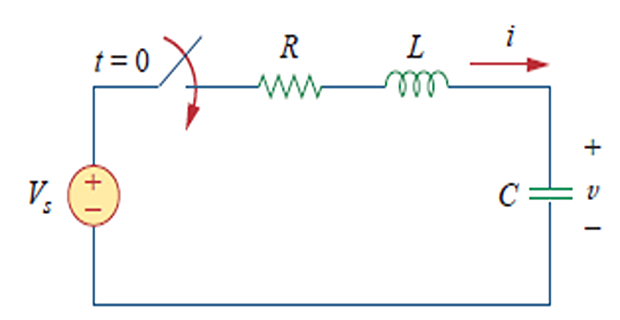
Solution: \(v(t)=v_{t}(t)+v_{s s}(t)\)
- \[\begin{aligned} v_{t}(t)&=A_{1} e^{s_{1} t}+A_{2} e^{s_{2} t} \quad \text { (Overdamped) } \\ v_{t}(t)&=\left(A_{1}+A_{2} t\right) e^{-\alpha t} \quad \text { (Critically damped) } \\ v_{t}(t)&=\left(A_{1} \cos \omega_{d} t+A_{2} \sin \omega_{d} t\right) e^{-\alpha t} \quad \text { (Underdamped) } \end{aligned}\]Transient response:
Steady-state response \(v_{ss}(t)= v(\infty) = V_{s}\)
\(A_1\) and \(A_2\) are found from initial conditions \(v(0)\) and \(dv(0)/dt\)
Problem
Find \(v(t)\) and \(i(t)\) for \(t>0\) considering \(R=5~\Omega\), \(R=4~\Omega\),and \(R=1~\Omega\).
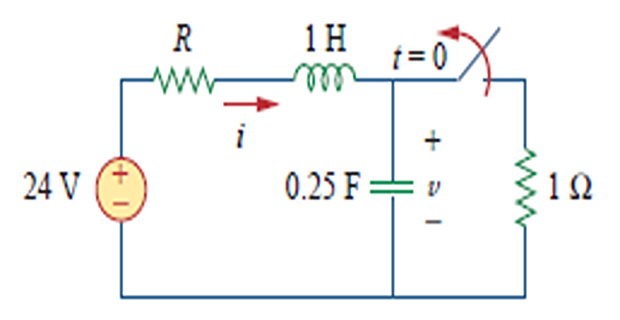
Case-I: \(R=5~\Omega\)
Case-II: \(R=4~\Omega\)
Case-III: \(R=1~\Omega\)
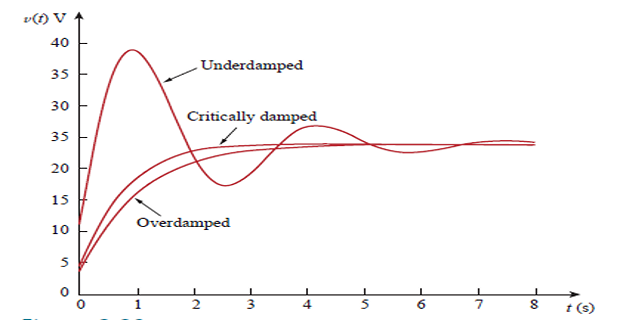
Step Response of a Parallel RLC Circuit
- \[\begin{aligned} &\frac{v}{R}+i+C \frac{d v}{d t}=I_{s} \quad \left(v=L \frac{d i}{d t} \right) \\ \Rightarrow & \frac{d^{2} i}{d t^{2}}+\frac{1}{R C} \frac{d i}{d t}+\frac{i}{L C}=\frac{I_{s}}{L C} \end{aligned}\]: Applying KCL for
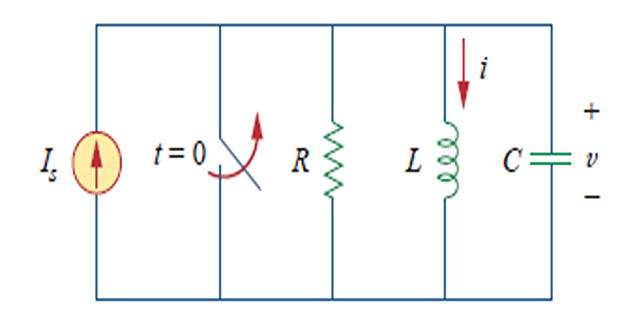
Solution: \(i(t)=i_{t}(t)+i_{s s}(t)\)
- \[\begin{aligned} i(t)&=I_{s}+A_{1} e^{s_{1} t}+A_{2} e^{s_{2} t} \quad \text { (Overdamped) } \\ i(t)&=I_{s}+\left(A_{1}+A_{2} t\right) e^{-\alpha t} \quad \text { (Critically damped) } \\ i(t)&=I_{s}+\left(A_{1} \cos \omega_{d} t+A_{2} \sin \omega_{d} t\right) e^{-\alpha t} \quad \text { (Underdamped) } \end{aligned}\]Response:
\(A_1\) and \(A_2\) are found from initial conditions \(i(0)\) and \(di(0)/dt\)
Problem
Determine \(i(t)\) and \(i_R(t)\) for \(t>0\)
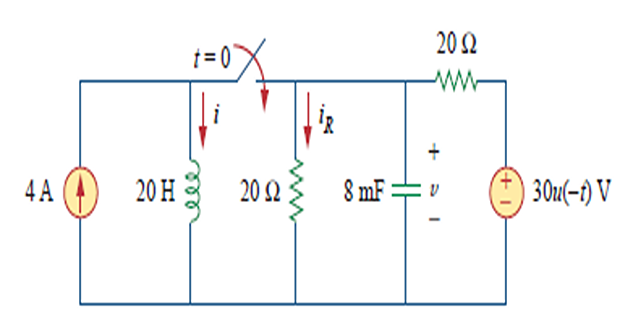
- \[i(0)=4~\mathrm{A}\], the switch is open For
- \[v(0) = \dfrac{20}{20+20}\times 30 = 15~\mathrm{V}\]Initial capacitor voltage
For \(t<0\), the switch is closed and we have parallel RLC circuit with current source
Resistance \(R=20||20=10~\Omega\)
- \[i(t)=I_{s}+A_{1} e^{-11.978 t}+A_{2} e^{-0.5218 t}\]\(i(t)\)\(I_{s}=4\), we have the overdamped case. Since
We now use the initial conditions to determine \(A_{1}\) and \(A_{2}\).
- \[i(0)=4=4+A_{1}+A_{2} \quad \Rightarrow \quad A_{2}=-A_{1}\], At
- \[\frac{d i}{d t}=-11.978 A_{1} e^{-11.978 t}-0.5218 A_{2} e^{-0.5218 t}\], Taking the derivative of
- \[\frac{d i(0)}{d t}=-11.978 A_{1}-0.5218 A_{2}\], At
- \[L \frac{d i(0)}{d t}=v(0)=15 \quad \Rightarrow \quad \frac{d i(0)}{d t}=\frac{15}{L}=\frac{15}{20}=0.75\]\[0.75=(11.978-0.5218) A_{2} \quad \Rightarrow \quad A_{2}=0.0655\]But
Thus, \(A_{1}=-0.0655\) and \(A_{2}=0.0655\).
- \[i(t)=4+0.0655\left(e^{-0.5218 t}-e^{-11.978 t}\right) \mathrm{A}\]in gives the complete solution as and Inserting
- \[i_{R}(t)=\frac{v(t)}{20}=\frac{L}{20} \frac{d i}{d t}=0.785 e^{-11.978 t}-0.0342 e^{-0.5218 t} \mathrm{~A}\]and , we obtain From
Second Order : Problem Solving Steps
Determine initial and final values \(x(0)\) and \(d x(0) / d t\) and \(x(\infty)\)
Turn off independent sources and find the transient response \(x_{t}(t)\) by applying KCL and KVL.
Determine \(2^{nd}\) order D.E. and its characteristic roots.
Determine response case : overdamped, critically damped, or underdamped,
Obtain \(x_{t}(t)\) with two unknown constants
Obtain the steady-state response as \(x_{s s}(t)=x(\infty)\) where \(x(\infty)\) is the final value of \(x\), obtained in step 1 .
- \[x(t)=x_{t}(t)+x_{s s}(t)\]The total response is
Determine the constants of transient response using \(x(0)\) and \(d x(0) / d t\), determined in step 1 .